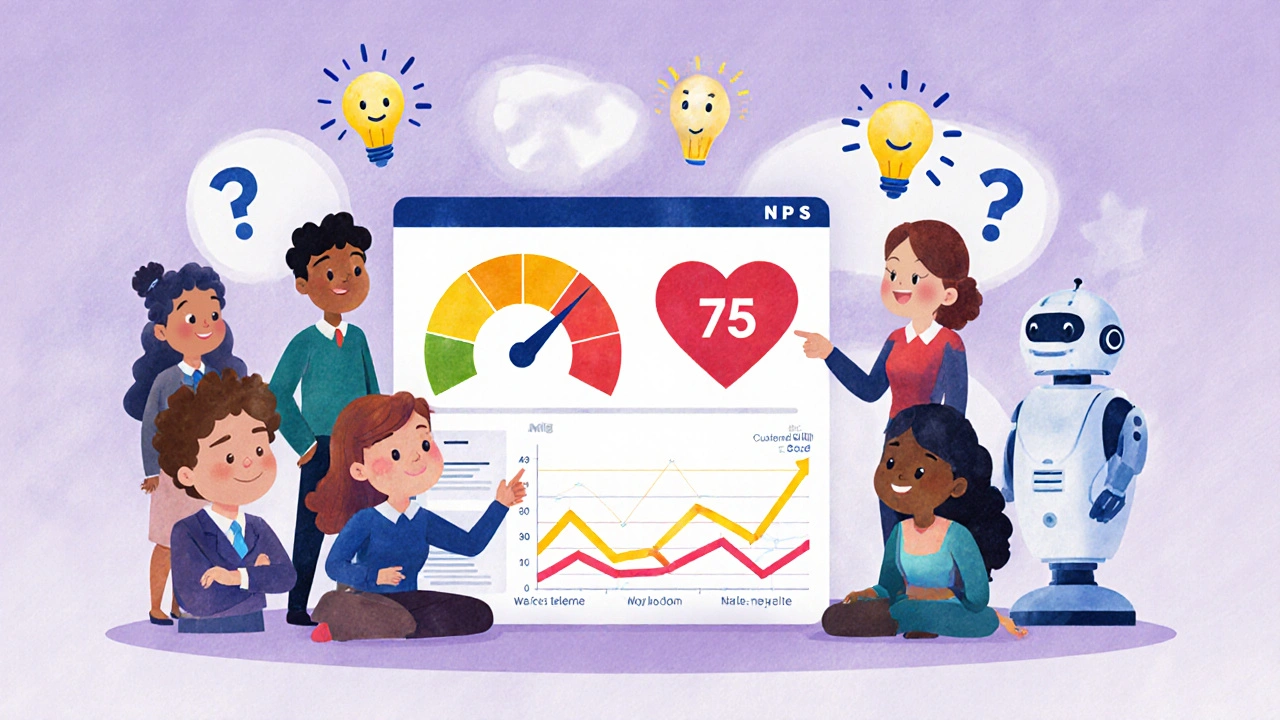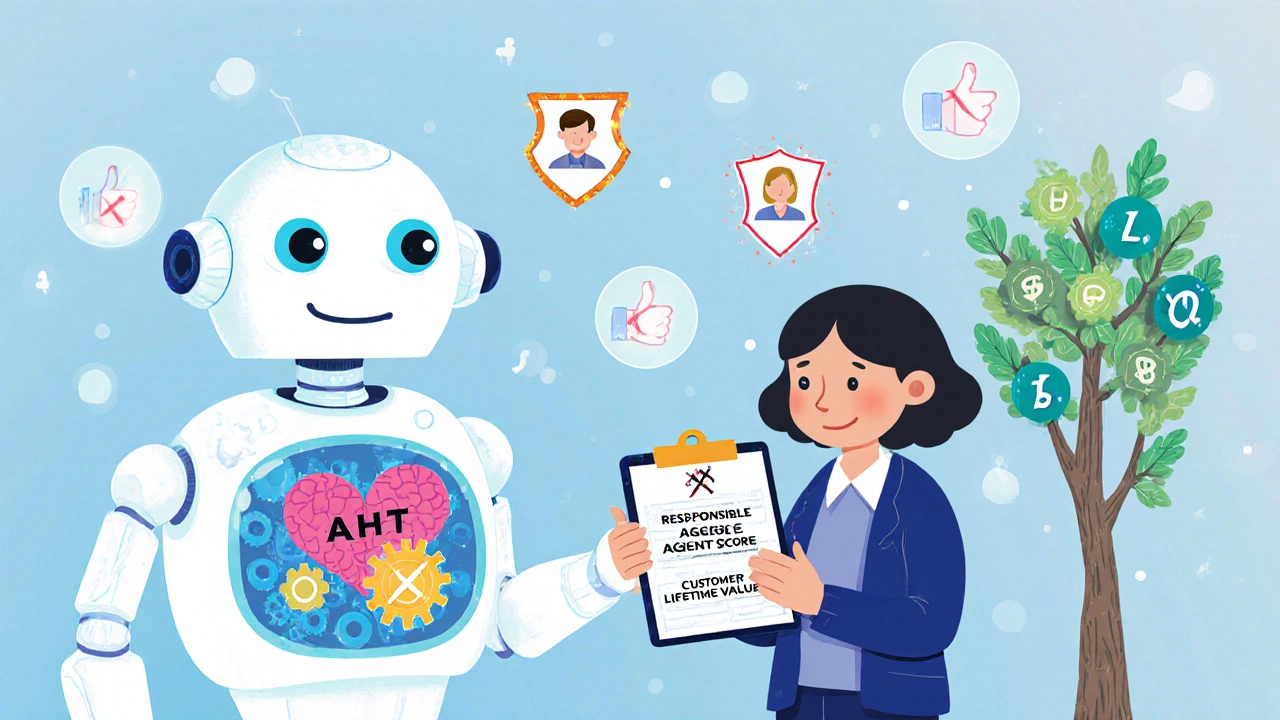When you call a support line, you don’t care about how long the agent spent on the last call. You care if your problem got fixed - and if they made you feel heard. But behind the scenes, companies are tracking dozens of numbers to decide who’s doing well and who needs help. These aren’t just numbers on a screen. They’re agent performance metrics - the real-life scorecards that shape how support teams work, how customers feel, and whether a business stays profitable.
What Agent Performance Metrics Actually Measure
Agent performance metrics break down into three types: numbers you can count, feelings you can feel, and processes you can track. Each tells a different story.
Quantitative metrics are the easiest to collect. Average Handle Time (AHT) is one of the most common. It’s calculated by adding up talk time, hold time, and after-call work, then dividing by the number of calls. In retail, a good AHT is around 4.5 minutes. In tech support, it’s closer to 11.2 minutes. Why the difference? A simple billing question shouldn’t take as long as troubleshooting a broken server. But here’s the trap: if you push agents to lower AHT too hard, they’ll rush. And rushing leads to repeat calls - which actually makes AHT worse over time.
Qualitative metrics measure how customers feel. Customer Satisfaction Score (CSAT) asks customers to rate their experience on a scale, usually 1 to 5. Top performers see 75-85% of responses as "satisfied" or better. But CSAT has a flaw: people in Germany are less likely to give a 5 than people in the U.S., even for the same service. That’s cultural bias - and it skews results if you don’t account for it.
Then there’s First Contact Resolution (FCR). This one’s simple: did the agent fix the issue on the first try? Industry leaders hit 70-80%. And here’s the kicker: every 1% increase in FCR lifts customer satisfaction by 1%. That’s because customers hate repeating themselves. FCR is the strongest predictor of loyalty - even stronger than CSAT.
Team Metrics That Actually Drive Business Results
Individual stats matter, but teams win or lose together. That’s why companies track metrics that reflect collective performance.
Net Promoter Score (NPS) asks customers one question: "How likely are you to recommend us?" Responses range from 0 to 10. Promoters (9-10) minus Detractors (0-6) gives you your NPS. Scores above 50 are excellent. But NPS doesn’t just measure satisfaction - it predicts revenue. Bain & Company found that a 5% increase in customer retention can boost profits by 25-95%. And guess what drives retention? FCR and low effort.
That’s where Customer Effort Score (CES) comes in. Instead of asking "Are you satisfied?" CES asks, "How easy was it to solve your problem?" on a 1-5 scale. Top teams average 1.8. Why does this matter? Gartner found effort correlates more strongly with repeat purchases than satisfaction does. If your customer has to call twice, explain their problem three times, or jump through hoops to get help - they’re gone. CES is replacing CSAT as the real loyalty indicator.
For AI agents, a new metric has emerged: Task Completion Rate (TCR). This tracks how often an AI resolves an issue without handing it off to a human. In simple cases - like resetting a password - top AI systems hit 92%. In complex ones - like resolving a billing dispute with multiple account layers - it drops to 60-70%. But TCR isn’t just about success. It also measures "hallucinations" - when an AI makes up facts. That’s a risk no human agent has to worry about.

The Hidden Cost of Bad Metrics
Not all metrics are created equal. Some help. Some hurt.
Schedule Adherence tracks whether agents are on the phone when their shift says they should be. Sounds fair, right? But critics say it’s toxic. Bruce Temkin, a customer experience expert, points out that tracking it below 85% creates stress without improving service. Agents end up ignoring real customer needs just to stay on the clock.
And then there’s the data overload problem. A 2023 McKinsey study of 150 contact centers found that top performers track 7-12 metrics. Struggling teams track 20+. More numbers don’t mean better decisions. They mean confusion. One agent on Reddit wrote: "FCR helped me find my knowledge gaps - but AHT pressure made me rush calls. I ended up getting more repeat contacts."
Companies that misuse metrics see turnover spike. One Trustpilot review said their company’s obsession with AHT pushed agent turnover from 15% to 35% in six months. That’s not efficiency - that’s burnout.
What the Best Teams Do Differently
The best teams don’t just track metrics - they use them to fix problems, not punish people.
They start small. Spinify’s advice: pick 3-5 metrics tied directly to business goals. If your goal is reducing repeat calls, focus on FCR. If you want happier customers, track CES. Don’t try to measure everything at once.
They connect metrics to real outcomes. Salesforce users reported a 27% NPS boost after linking agent performance to customer journey maps. That means seeing not just that an agent resolved a call, but how that call fit into the customer’s entire experience - from website visit to post-call survey.
They use AI to see everything. In 2024, 65% of contact centers now analyze 100% of interactions using AI. Before, they sampled just 1-2%. Now they can spot patterns: Which agents use calming language? Which scripts lead to escalations? Which customers get the same issue repeated because no one updated the knowledge base?
They train people to understand the data. Basic metric training takes 8-16 hours. Advanced roles need 40+ hours. Certifications like COPC’s Performance Management Professional require 120 hours. That’s not a cost - it’s an investment. If your team doesn’t know how to read the numbers, the data is useless.

What’s Changing in 2025
The game is shifting fast.
Zoom launched a new metric in May 2024: the Sentiment Resolution Score. It doesn’t just track if a call ended well - it tracks how the customer’s mood changed during the call. Did they start angry and end calm? That’s a win.
Salesforce introduced Customer Health Metrics in June 2024. These tie agent performance to lifetime value. If an agent helps a customer upgrade their plan or refer a friend, that’s recorded. Suddenly, good service isn’t just about fixing problems - it’s about growing revenue.
By 2026, Gartner predicts 70% of centers will stop using AHT as a target and start using Customer Lifetime Value instead. That’s huge. It means companies are finally moving away from counting minutes and toward measuring value.
And ethical AI is coming. Galileo AI is launching a "Responsible Agent Score" in Q4 2024. It will track AI bias, hallucinations, and transparency. If an AI gives a wrong answer and hides it, that counts against its score.
Where to Start
If you’re running a small team - 1 to 20 agents - start with Zendesk Explore or similar tools. They cost about $49 per agent per month. Set up FCR, CSAT, and CES. Track them for 30 days. Look for patterns. Don’t rush to change anything. Just observe.
If you’re in a large company with 500+ agents, you’ll need custom analytics. Budget $150,000 to $500,000 a year. But don’t just buy software. Build a team that understands it. Hire someone with COPC certification. Train managers to use data as a coaching tool, not a weapon.
And remember: metrics should serve people, not the other way around. A perfect score on every KPI means nothing if your agents are miserable or your customers keep leaving.
The future of customer service isn’t about who handles the most calls. It’s about who makes the fewest customers feel like a burden.
What’s the most important agent performance metric?
There’s no single "most important" metric - it depends on your goal. If you want to reduce repeat contacts, focus on First Contact Resolution (FCR). If you want to increase customer loyalty, track Customer Effort Score (CES). If you want to grow revenue, link agent performance to Customer Lifetime Value. FCR and CES have the strongest ties to retention and satisfaction, making them the most reliable starting points.
Can AI agents be measured the same way as humans?
No. Traditional metrics like AHT or CSAT don’t capture AI-specific behaviors. AI needs new metrics like Task Completion Rate (TCR), hallucination rate, and context retention. For example, an AI might resolve a call quickly (low AHT), but give the customer wrong information - which leads to more calls later. That’s why AI-specific scores like Galileo AI’s "Responsible Agent Score" are emerging in 2024-2025.
Why is AHT often criticized as a bad metric?
AHT pushes agents to end calls faster, which often leads to rushed solutions, incomplete fixes, and more repeat contacts. Studies show companies that optimize only for low AHT see 15-20% higher repeat call rates. This hurts customer experience and ultimately increases costs. Smart teams use AHT as a diagnostic tool - not a target - and pair it with FCR and CES to balance speed and quality.
How many metrics should a team track?
Top-performing teams track 7-12 core metrics. Teams that track more than 15 often see diminishing returns and employee burnout. Start with 3-5 metrics tied to your top business goal - like reducing escalations or improving retention - and add others only when you have the data infrastructure and team training to use them effectively.
What’s the difference between CSAT and NPS?
CSAT measures satisfaction with a single interaction - usually on a 1-5 scale. NPS measures overall loyalty by asking how likely a customer is to recommend your company on a 0-10 scale. CSAT is tactical; NPS is strategic. A customer might be satisfied with one call but still wouldn’t recommend you - meaning NPS is lower. NPS better predicts long-term revenue and retention.
Do these metrics work for remote or hybrid teams?
Yes - and they’re even more critical for remote teams. Without physical oversight, data becomes your eyes and ears. Metrics like FCR, CES, and AI-driven sentiment analysis help managers spot issues early, even when agents aren’t in the same room. The key is using real-time dashboards and coaching tools that give feedback without micromanaging.
How do GDPR and AI regulations affect these metrics?
GDPR and CCPA require that customer feedback used in metrics be collected with consent and stored securely. New EU AI regulations also demand transparency in how AI agents are evaluated. You can’t use personal data to score agents without clear policies. If you’re using AI to analyze voice or chat data, you must disclose how it works and allow customers to opt out. Compliance isn’t optional - it’s part of your metric design.
What tools are best for tracking these metrics?
Small teams can start with Zendesk Explore ($49/agent/month) or Nice CXone. Mid-sized teams often use Verint or Salesforce Service Cloud. Enterprises need custom platforms like Calabrio or NICE inContact. Look for tools that offer real-time dashboards, AI-powered insights, and easy integration with your CRM. The best tools don’t just show numbers - they explain what they mean.
